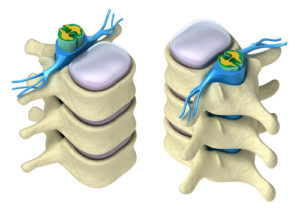
Spinal Vertebra and Nerves Exiting Spinal Chord
With our hectic modern lifestyle, there can be so many reasons why we don't have a healthy spine. As I have explored in my previous articles, keeping healthy involves four key things; state of mind, diet, exercise and posture.
The spinal cord and nerve roots are housed in a bony structure, the spine, to minimise fraying and compression to sensitive neural structures, further protected by cushioning discs and strong muscles.
If you are unable to eat a healthy diet or have chronic stress, the gut cannot absorb nutrients effectively. The body then starts to crave these missing nutrients and literally rapes the spinal bones of minerals to sustain the vital organs. This accelerates wear and tear in the small finely chiselled spinal facet joints that allow us to twist and turn. They become prematurely arthritic and fire off pain receptors.
Daily impacts due to heavy footsteps on solid surfaces, cause faster wear and tear. Furthermore, with sustained poor posture in walking and sitting, amplified by not drinking enough water, the cushioning discs will crack and bulge. Then the fragile nerves are put at further risk by weak muscles. They turn into sensitive dysfunctional nerves which cause muscle contractures, accelerating arthritis, disc damage and general aging.
Hence the way we move will affect the harmonious flow of movement up through all the small joints in the spine. The correct structural alignment of feet, legs, pelvis and spine is very important, especially if you are very active and sporty. The science of how we move is called biomechanics, a physical expression of health, and a predictor of future problems.
So many times symptoms appear totally unrelated to the spine and yet unless recognized and treated the culprit lies dormant and the problem keeps reoccurring. Many times the symptoms of pain, numbness, weakness and pins and needles can be anywhere else in the body but the spine. So often, seemingly unrelated painful conditions such as osteoarthritis, tendinitis or unrelenting sports injury can only be resolved specialist neuropathic treatment to the spine. I firmly believe if anyone has a problem anywhere in the body the neural link to the spine must be assessed. Furthermore with shortened muscles compressing nerves such as sciatica in the leg, or brachialgia in the arm, the best way to quickly release the tight muscle contractures is with laser and a specialist pain treatment called GunnIMS. We are the only centre in Europe to offer teaching internships in IMS pain relief, after being awarded the highest accolade in treatment and lecturing internationally on this subject.
We very much embrace this approach in the clinic, with our specific diagnostic physical and functional tests.
Get in touch to find out more.

